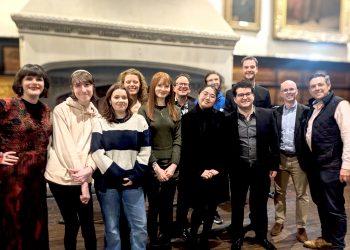A couple of weeks ago, we had our first taste at working on the Vespers with Robert Hollingworth, and I came home with my brain melting out of my ears and, above all, a sense of what the early music specialists, conductors, singers and instrumentalists, have to do when they perform this music. For every note, and every word, I had to remember and do what I’d been told about tuning, rhythm, pronunciation, and the placing of words, all whilst sight-reading in a slightly unfamiliar musical idiom.
Although Robert’s performance decisions are clearly based on a serious amount of scholarship, what struck me during the day was that everything also seemed to make absolute sense in musical and practical terms. The first point that he made regarded the performance space for the Vespers. We associate the Vespers with Venice, but Monteverdi was still in Mantua when he wrote them, so the music isn’t necessarily designed to have the two choirs bouncing things back and forth across vast distances – and so it can be a lot of hard work and no fun for singers to do it that way. This allows us to bring the choir and orchestra forward when we sing it in Durham Cathedral, to create a more intimate setting, without having to battle against the acoustic problems caused by the tower. We’re probably also a much larger choir than the Vespers were intended for. Robert did say, “you can do it anyway you like, he’s dead”, but we will have to think about clarity and lightness, and not imagine that we’re blasting away inside St Mark’s.
One of Robert’s particular areas of research is the relationship between the double and triple time signatures in Monteverdi’s music. His conclusion is that the duple times are slightly faster than they’re often performed, but the corresponding triple times become much slower (I didn’t write it down, but I think it’s that one bar of two = one bar of three, instead of sub-dividing a beat of the double time into three). It makes some of the passages of the Vespers feel much more graceful; a dance instead of a gallop. I’m lucky in this respect not to have sung the Vespers before, as it means I have no ingrained habits to iron out, and compared to what I’m used to hearing, I can see the advantages of Robert’s conclusions.
As a female alto, I learnt from the workshop that I have to face up now to a rather sad fact. Monteverdi did not write the Vespers for me. Even singing at the Venetian pitch of A465 (a semi-tone up) a lot of it is going to be uncomfortably low, particularly for the first altos, so we’ll have to accept help from the tenors, and in the transposition we’re working with, it looks as if we’ll be more or less redundant in the Lauda Jerusalem. It’s yet another example of the amount of work that goes into putting the Vespers together: our conductors Julian and Francesca will have to work with Robert to figure out exactly who sings what, and which part takes which line. Personally, I’m looking forward to working my low notes a bit, but I will have to take it with a good grace if we get dropped from some bits.
We also have to get used to working to the intonation used in Monteverdi’s day, as that’s the way that the accompanying instruments will be tuned. We covered this with Robert before in 2014 (which I wrote about here) but it was good to be reminded. This time, I remembered that our digital piano has settings for different tuning systems, so I’ve been able to try it out, to hear the differences, and to understand it at my own pace. Last time, it was helpful advice that made a noticeable difference to our tuning when we were singing Byrd, but this time, it’s going to be absolutely essential that we get it right, because of the instruments, so I think we’ll have to get used to rehearsing without the piano right from the start. We also revised Robert’s advice and exercises for getting really good Italian pronunciation going, with early consonants, which again was helpful, and as an unintended consequence I ended up solving a recorder articulation difficulty.
Digesting all this whilst negotiating a fairly complicated score-layout and sight reading was tough, and by lunchtime I was exhausted and very conscious of how much work I’ve got to do before October, but I was glad to have my eyes opened so early. We wondered whether it would have been better to have more time looking at the music first, but I felt it was better just to go straight in with Robert and learn straightaway what he wanted from us. He was sympathetic but firm, saying that we needed to be “sight-reading by heart”. In fact, my heart was the only bit of me that wasn’t already occupied: that will come later.








